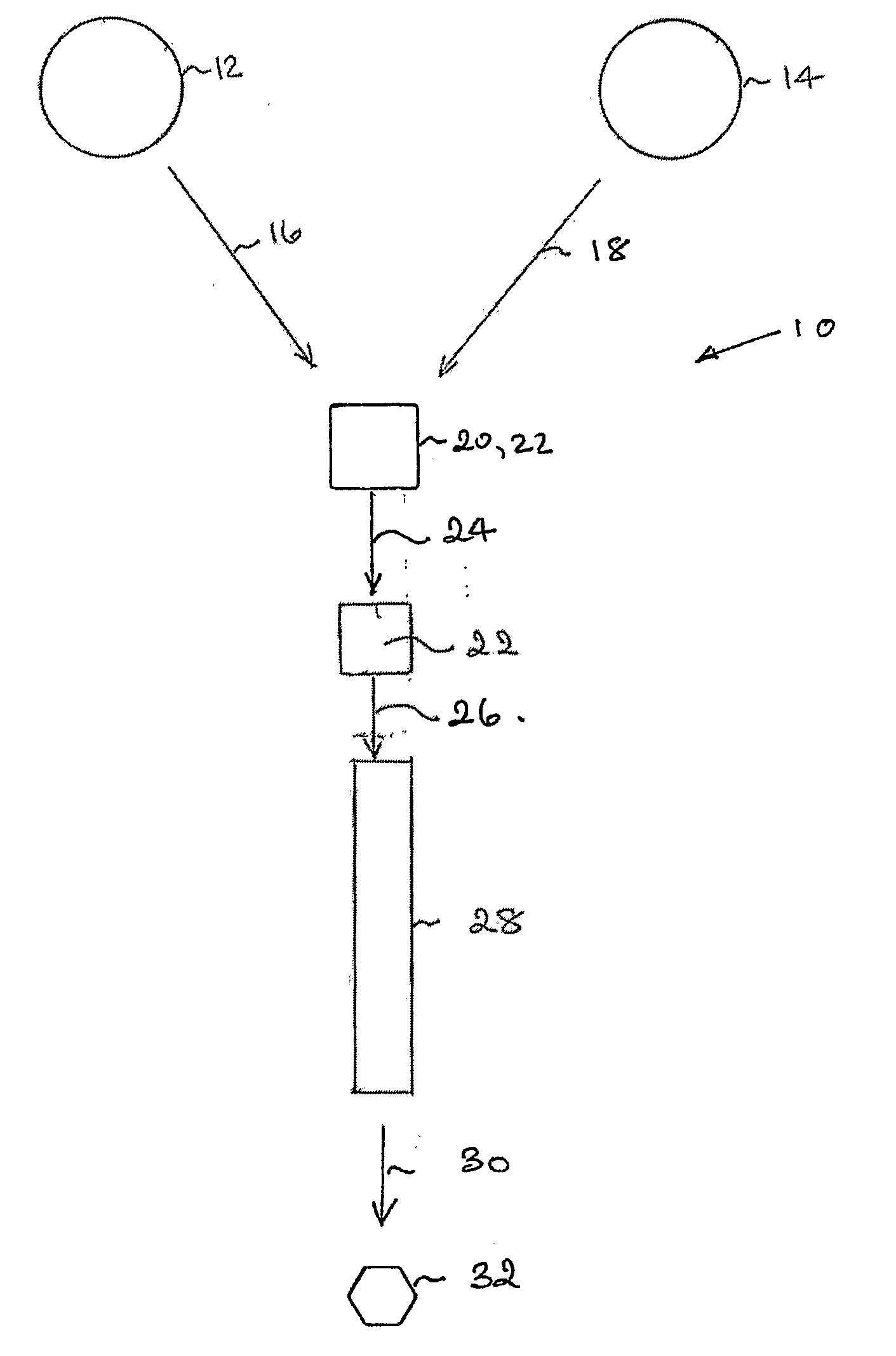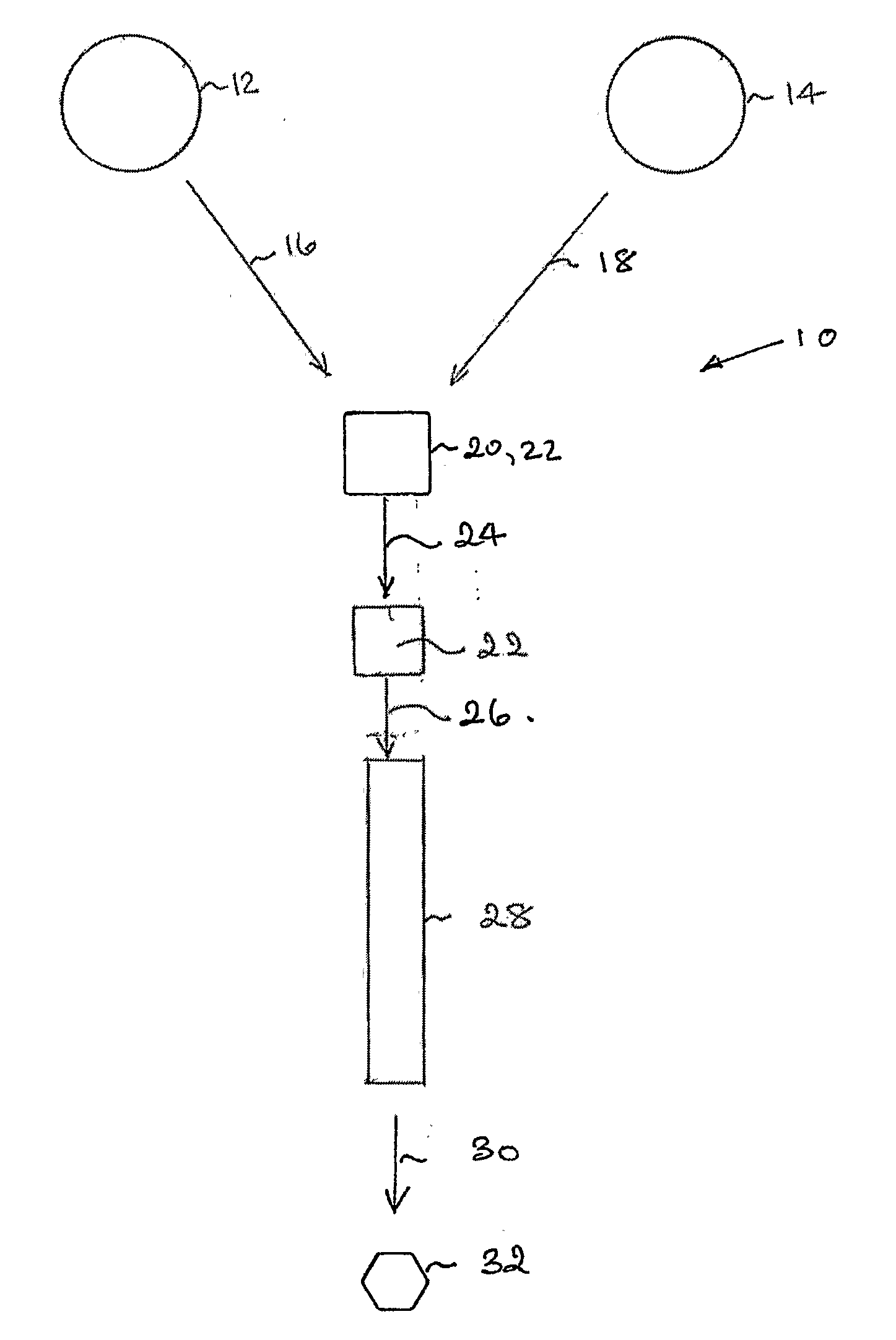[0010]In the case of one of the preferred matrix alloys, the Al—Fe—Cr—X
system, it is known that the addition of
chromium to the basic Al—Fe
system enhances the formation of second phase nanoquasicrystalline icosahedral particles in the matrix. As noted above, icosahedral particles may be defined as a quasicrystalline phase with no translational periodicity. The icosahedral structure possesses an extended orientational order, that is having full
rotational symmetry, but lacks translational symmetry. The icosahedral particles provide a strengthening phase to the surrounding aluminium-based alloy matrix tending to give retention of strength to the alloy at elevated temperatures, i.e. at temperatures at which conventional high-strength, structural aluminium alloys would weaken by, for example, grain coarsening,
precipitation of strengthening phases (over-aging) and other mechanisms. The basic Al—Fe—Cr alloy having a nominal composition of, in atomic % (as are subsequent examples), Al93-Fe4.2-Cr2.8, retains its icosahedral strengthening phase at temperatures up to about 350° C. but extended heating at this temperature causes the icosahedral particles to degrade by
diffusion thereby reducing the strength. Addition of
titanium to the alloy to form a nominal composition of Al93-Fe3-Cr2-Ti2 causes the icosahedral structure of the reinforcing particles to be retained at least up to temperatures of about 400° C. at which temperature it begins to degrade upon prolonged heating. However, addition of
niobium to the basic alloy to give a composition of Al93-Fe3-Cr2-Nb2 provides an alloy in which the icosahedral nanostructured quasicrystalline particle structure is retained at least to temperatures of about 500° C. and above, indeed, this beneficial structure appears to be retained even to the onset of melting.
[0016]It should be noted that the material from which the fibrillar constituent may be formed may not be in fibrillar form at the stage when it is combined with the aluminium-based alloy matrix material but may be converted into a fibrillar constituent during subsequent working of the base
composite material. There may be unsuitable ductile metals or alloys but this will depend to a great extent on the nature of the matrix alloy and whether or not there is any rapid and / or extensive inter-
diffusion effects between the aluminium-based alloy matrix material and the
fibril metal during
processing of the base composite material to its final form, wherein such
diffusion effects produce undesirable phases such as brittle phases, for example. However, the mere existence of inter-diffusion between the interfaces of the matrix and fibrillar material is not necessarily harmful and indeed may be beneficial in terms of bonding and internal strengthening.
[0019]Whilst it is accepted that such non-
metallic materials lack
ductility, they are extremely strong and possess a very high Young's Modulus. Therefore, such materials whilst not tending to improve the
ductility of the composite material according to the present invention may make such composite materials very strong with inter alia a very
high stiffness. Indeed, the incorporation of carbon nanotubes, for example, may produce a material having a significantly increased Young's modulus which would be a very valuable property especially in the
aviation industry.
[0034]The mechanical working processes applied to a compacted
powder and / or to a spray cast base billet serve to achieve a
fibril shape at nanoscale of the main reinforcement phase (the matrix second phase as defined hereinabove) and additionally to further reduce the
crystal size of the matrix material thus increasing strength.
[0035]Because the aluminium-based alloys of the matrix may preferably possess the advantageous structure wherein the matrix second phase may have nanostructured quasicrystalline particles which retain their strengthening capability at temperatures up to at least 500° C. depending upon the alloy
chemical composition, it is possible to produce the matrix alloy by an RSP
route, for example, as a
powder by an atomisation process, a ribbon or flakes by
melt spinning or a billet by spray
casting all as described hereinabove and, to work the material so produced without degrading the strengthening phase therein. For example, if a powder is produced that possesses the structure mentioned above it may be compacted and mechanically worked at relatively elevated temperatures for an aluminium-based alloy without degrading the
microstructure. However, the
ability to work the base billet of the composite material towards the desired
microstructure at relatively elevated temperatures without degrading the microstructure provides benefits in lower compacting and / or
extrusion pressures, improved cohesion and higher density which result in high strength and
toughness of the resulting material.
 Login to View More
Login to View More 

